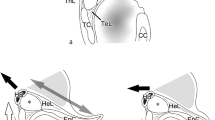Abstract
The suggested methods of the formation of intubation granuloma as well as carcinoma invasion in the area of posterior vocal ligament insertion have been controversial. One reason for divergent opinions is possibly based on different judgments of morphology in this region. The present study analyzed structures of the vocal ligament and vocalis muscle insertion at the vocal process by means of histological, immunohistochemical and electron microscopic methods. Investigations were performed in three planes on the vocal cords of 22 men and 19 women (aged 21–97 years). Inside the insertion zone of the vocal ligament at the vocal process three structures could be distinguished: hyaline cartilage at the base of arytenoid cartilage, elastic cartilage at its apex and the posterior elastic nodule in front of them. No perichondrium could be seen around the elastic nodule. In elastic nodules type I and type III collagen fibrils as well as elastic fibers formed a scissorlike meshwork around large fibroblasts. The vocalis muscle inserted at the perichondrium in the lateral part of the arytenoid skeleton by short tendons. At the insertion zone blood vessels of the vocalis muscle penetrated the perichondrium and reached the cartilaginous matrix. At the beginning of osteogenesis, the blood vessels connected with intraosseous blood vessels of the arytenoid. Connective tissue cells of the insertion zone and extracellular matrix components formed by these cells fulfilled a biomechanical function by equalizing the different elastic moduli of tendon, cartilage or bone. The lack of perichondrium around the lengthened posterior elastic nodule made formation of intubation granulomas caused by perichondritis in this area impossible. Loosened perichondrium or periosteum in the area of the insertion of the vocalis muscle at the vocal process, ossification and associated vascularization of the arytenoid skeleton permitted invasion of carcinomas into the arytenoid.
Similar content being viewed by others
References
Bargmann W (1977) Histologie und mikroskopische Anatomie, 7th edn. Thieme, Stuttgart
Becker W, Krahl H (1978) Die Tendopathien. Thieme, Stuttgart
Benjamin B, Roche J (1993) Vocal granuloma, including sclerosis of the arytenoid cartilage: radiographic findings. Ann Otol Rhinol Laryngol 102:756–760
Biermann H (1957) Die Knochenbildung im Bereich periostaler-diaphysärer Sehnen- und Bandansätze. Z Zellforsch 46: 635–671
Feder RJ, Michell MJ (1984) Hyperfunctional, hyperacidic, and intubation granulomas. Arch Otolaryngol Head Neck Surg 110:582–584
Fischer M, Tillmann B (1991) Tendinous insertions in the human thyroid cartilage plate: macroscopic and histologic studies. Anat Embryol (Berl) 183:251–257
Friedrich EP (1896) Die elastischen Fasern im Kehlkopfe. Arch Laryngol Rhinol (Berl) 103:184–209
Friedrich G, Kainz J, Freidl W (1993) Zur funktionellen Struktur der menschlichen Stimmlippe. Laryngorhinootologie 72: 215–224
Hirano M, Kurita S, Kiyokawa K, Sato K (1986) Posterior glottis-morphological study in excised human larynges. Ann Otol Rhinol Laryngol 95:576–581
Hirano M, Yoshida T, Kurita S, Kiyokawa K, Sato K, Tateishi O (1987) Anatomy and behavior of the vocal process. In: Baer T, Sasaki C, Harris KS (eds) Laryngeal function in phonation and respiration. Little & Brown, London, pp 3–13
Hommerich KW (1984) Histomorphological behavior of the tumor growth in the glottic region. In: Wiegand ME, Steiner W, Stell PM (eds) Functional partial laryngectomy: conservation surgery for carcinoma of the larynx. Springer, Berlin Heidelberg New York, pp 134–138
Imhofer R (1905) Die elastischen Einlagerungen am Vorderende der Stimmbänder. Z Heilkd 26:176–187
Katzenstein J (1902/1903) Über die elastischen Fasern im Kehlkopfe mit besonderer Berücksichtigung der funktionellen Struktur und der Funktion der wahren und der falschen Stimmlippe. Arch Laryngol 13:329–352
Kleinsasser O (1987) Spezielle Morphologie der Stimmlippenkarzinome. In: Kleinsasser O (ed) Tumoren des Larynx und des Hypopharynx. Thieme, Stuttgart, pp 85
Knese KH, Biermann H (1958) Die Knochenbildung an Sehnen- und Bandansätzen im Bereich ursprünglich chondraler Apophysen. Z Zellforsch 49:142–187
Maroudas A, Mizraki J, Katz EP, Wachtel EJ, Soudry M (1986) Physicochemical properties and functional behavior of normal and osteoarthritic cartilage. In: Kuettner K, Schleyerbach R, Hascall VC (eds) Articular cartilage biochemistry. Raven, New York, pp 311–329
McFerran DJ, Abdullah V, Gallimore AP, Path MRC, Pringle MB, Croft CB (1994) Vocal process granulomata. J Laryngol Otol 108:216–220
Ossoff RH, Karlan MS, Sisson GA (1983) Posterior commissure laryngoscope for carbon dioxide laser surgery. Ann Otol Rhinol Laryngol 92: 361
Paulsen F, Tillmann B (1993) Ansatzstrukturen des Ligamentum vocale und des Musculus vocalis. Eur Arch Otorhinolaryngol Suppl 2:215–216
Paulsen F, Tillmann B (1995) Struktur und Funktion der Noduli elastici des Ligamentum vocale. Verh Anat Ges Suppl Anat Anz 178:325–326
Petersen H (1930) Die Organe des Skelettsystems. In: Möllendorff W von (ed) Handbuch der mikroskopischen Anatomie des Menschen. Springer, Berlin, pp 521–678
Reinke F (1897) Über die funktionelle Struktur der menschlichen Stimmlippe. Mit besonderer Berücksichtigung des elastischen Gewebes. Anat Hefte 9:104–115
Rheiner H (1852) Beiträge zur Histologie des Kehlkopfes. Dissertation, University of Würzburg
Romeis B (1989) Mikroskopische Technik. Oldenbourg, München Wien
Schaefer SD, Close LG, Brown OE (1986) Mobilization of the fixated arytenoid in the stenotic posterior laryngeal commissure. Laryngoscope 96:656–659
Tillmann B, Schünke M (1989) Untersuchungen zur Struktur der Plica vocalis des Menschen. Arch Ohren Nasen Kehlkopfh Suppl 2:11–18
Tillmann B, Schünke M (1991) Struktur und Funktion extrazellulärer Matrix. Anat Anz Suppl 168:23–36
Whited RE (1983) Posterior commissure stenosis post longterm intubation. Laryngoscope 93:1314–1318
Author information
Authors and Affiliations
Rights and permissions
About this article
Cite this article
Paulsen, F., Tillmann, B. Functional and clinical anatomy of the posterior insertion of the human vocal ligament. Eur Arch Otorhinolaryngol 254, 442–448 (1997). https://doi.org/10.1007/BF02439976
Received:
Accepted:
Issue Date:
DOI: https://doi.org/10.1007/BF02439976




